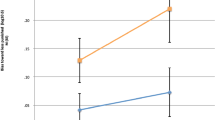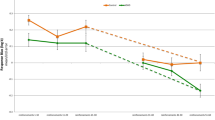Abstract
Investigated was a deficit in avoidance learning in situations of competing rewards and punishments in boys with behavior disorders. This learning style has been found to differentiate adults with psychopathy and controls and has been labeled “reward dominance.” The present study investigated the reward dominance paradigm in a group of 9- to 13-year-old boys with disruptive behavior disorders (N=21) and a normal control group (N=22). Subjects played four computer games programmed to provide the subject with a steadily decreasing ratio of rewards to punishments. Although the groups did not differ initially on the number of trials played, significant group differences emerged when measures of anxiety were included in the analysis. That is, boys with disruptive behavior disorders played more trials (reward dominance) only when the effect of anxiety was controlled. These findings are consistent with Gray's biobehavioral theory of personality and are also consistent with research indicating that anxiety is an important marker for a distinct subgroup of children with behavior problems.
Similar content being viewed by others
References
Achenbach, T. M. (1991).Manual for the Child Behavior Checklist/4–18 and 1991 Profile. Burlington: University of Vermont, Department of Psychiatry.
American Psychiatric Association (1987).Diagnostic and statistical manual of mental disorders (rev. 3rd. ed.). Washington, DC: APA.
Daugherty, T. K., & Quay, H. C. (1991). Response perseveration and delayed responding in childhood behavior disorders.Journal of Child Psychology and Psychiatry, 32, 453–461.
Eysenck, H. J. (1957).The dynamics of anxiety and hysteria. New York: Praeger.
Eysenck, H. J. (1967).The biological basis of personality. Springfield, IL: Charles C Thomas.
Frick, P. J., & Lahey, B. B. (1991). Nature and characteristics of attention-deficit hyperactivity disorder.School Psychology Review, 20, 162–172.
Gray, J. A. (1970). The psychophysiological basis of introversion-extraversion.Behaviour Research and Therapy, 8, 249–266.
Gray, J. A. (1982).The neuropsychology of anxiety: An enquiry into the functions of the septo-hippocampal system. Oxford: Oxford University Press.
Gray, J. A. (1987).The psychology of fear and stress (2nd ed.). Cambridge: Cambridge University Press.
Harpur, T. J., Hare, R. D., & Hakstian, A. R. (1989). Two-factor conceptualization of psychopathy: Construct validity and assessment implications.Psychological Assessment, 1, 6–17.
Hinshaw, S. P. (1987). On the distinction between attentional deficits/hyperactivity and conduct problems/aggression in child psychopathology.Psychological Bulletin, 101, 443–463.
Kaufman, A. S., & Kaufman, N. L. (1990).Kaufman Brief Intelligence Test: Manual. Circle Pines, MN: American Guidance Service.
Lahey, B. B., Loeber, R., Stouthamer-Loeber, M., Christ, M. A. G., Green, S., Russo, M. F., Frick, P. J., & Dulcan, M. (1990). Comparison of DSM-III and DSM-III-R diagnoses for prepubertal children: Changes in prevalence and validity.Journal of the American Academy of Child and Adolescent Psychiatry, 29, 620–626.
Lahey, B. B., Loeber, R., Quay, H. C., Frick, P. J., & Grimm, J. (1992). Oppositional defiant disorder and conduct disorders: Issues to be resolved for DSM-IV.Journal of the American Academy of Child and Adolescent Psychiatry, 31, 539–546.
McBurnett, K., Lahey, B. B., Frick, P. J., Risch, C., Loeber, R., Hart, E. L., Christ, M. A. G., & Hanson, K. (1991). Anxiety, inhibition, and conduct disorder in children. II. Relation to salivary cortisol.Journal of the American Academy of Child and Adolescent Psychiatry, 30, 192–196.
Newman, J. P. (1980). The role of response perseveration in the learning deficits of psychopaths (doctoral dissertation, Indiana University, 1979).Dissertation Abstracts International, 41, 5012–5013.
Newman, J. P., & Kosson, D. S. (1986). Passive avoidance learning in psychopathic and nonpsychopathic offenders.Journal of Abnormal Psychology, 95, 252–256.
Newman, J. P., Patterson, C. M., & Kosson, D. S. (1987). Response perseveration in psychopaths.Journal of Abnormal Psychology, 96, 145–148.
Newman, J. P., Widom, C. S., & Nathan, S. (1985). Passive avoidance syndromes of disinhibition: Psychopathy and extraversion.Journal of Personality and Social Psychology, 48, 1316–1327.
Pelham, W. E., Gnagy, E. M., Greenslade, K. E., & Milich, R. (1992). Teacher ratings of DSM-III-R symptoms for the disruptive behavior disorders.Journal of the American Academy of Child and Adolescent Psychiatry, 31, 210–218.
Quay, H. C., & Love, C. T. (1977). The effect of a juvenile diversion program on rearrests.Criminal Justice and Behavior, 4, 377–396.
Quay, H. C., & Peterson, D. R. (1987).Manual for the Revised Behavior Problem Checklist. Coral Gables, FL: University of Miami.
Robins, L. N. (1966).Deviant children grown up. Baltimore: Williams & Wilkins Company.
Scerbo, A., Raine, A., O'Brien, M., Chan, C., Rhee, C., & Smiley, N. (1990). Reward dominance and passive avoidance learning in adolescent psychopaths.Journal of Abnormal Child Psychology, 18, 451–463.
Shapiro, S. K., Quay, H. C., Hogan, A. E., & Schwartz, K. P. (1988). Response perseveration and delayed responding in undersocialized aggressive conduct disorder.Journal of Abnormal Psychology, 97, 371–373.
Spitzer, R. L., Davies, M., Barkley, R., & Costello, A. (1991). The DSM-III-R field trials for the disruptive behavior disorders.Journal of the American Academy of Child and Adolescent Psychiatry, 29, 690–697.
Walker, J. L., Lahey, B. B., Russo, M. F., Frick, P. J., Christ, M. A., McBurnett, K., Loeber, R., Stouthamer-Loeber, M., & Green, S. M. (1991). Anxiety, inhibition, and conduct disorder in children. I. Relations to social impairment.Journal of the American Academy of Child and Adolescent Psychiatry, 30, 187–191.
Widom, C. S., & Newman, J. P. (1985). Characteristics of non-institutionalized psychopaths. In D. P. Farrington & J. Gunn (Eds.),Aggression and Dangerousness (pp. 57–80). New York: John Wiley & Sons.
Author information
Authors and Affiliations
Rights and permissions
About this article
Cite this article
O'Brien, B.S., Frick, P.J. & Lyman, R.D. Reward dominance among children with disruptive behavior disorders. J Psychopathol Behav Assess 16, 131–145 (1994). https://doi.org/10.1007/BF02232724
Accepted:
Issue Date:
DOI: https://doi.org/10.1007/BF02232724




